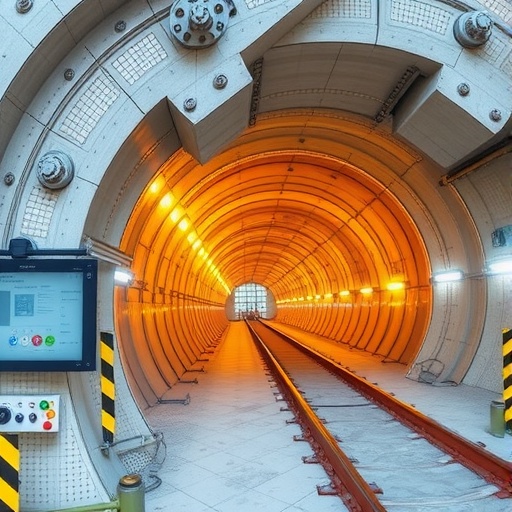In the evolving field of civil engineering, tunnel construction remains one of the most complex and technically demanding activities. The stability and safety of tunnels hinge critically on the design of efficient support systems, which must be carefully calibrated to withstand diverse geological conditions and dynamic loads. A recent groundbreaking study by Lawal, Zvarivadza, Onifade, and their colleagues, published in Environmental Earth Sciences, introduces a novel approach that leverages machine learning algorithms to optimize tunnel support design, signaling a transformative advancement in geotechnical engineering practice.
Traditional tunnel support design relies heavily on empirical methods, geological surveys, and engineers’ experience to estimate the necessary reinforcement, often leading to conservative or excessively costly measures. This trial-and-error approach, compounded by the heterogeneity of underground formations, introduces uncertainties and inefficiencies during construction. The research team tackled this longstanding challenge by developing predictive models based on extensive datasets, capturing the intricate interplay between geological variables and support system performance.
Central to the team’s methodology is the utilization of multiple machine learning models, including regression algorithms and neural networks, trained on a comprehensive geological and geotechnical dataset derived from past tunnel projects. These models analyze parameters such as rock mass quality, in-situ stress conditions, groundwater presence, and excavation methods, correlating them with historical support system outcomes. The resulting predictive framework enables the determination of optimal support strategies tailored to specific site conditions, drastically reducing risk margins and construction costs.
One of the remarkable aspects of the study is the integration of real-time monitoring data into the machine learning algorithms. Sensors embedded in tunnels during excavation provide continuous streams of ground movement, stress distribution, and deformation metrics. This live data feedback loop allows adaptive model retraining, improving predictive accuracy as the tunnel progresses. Consequently, engineers can dynamically adjust support systems in response to evolving geological responses, a leap forward from static design paradigms.
The research also addresses the challenge of model interpretability, a critical concern for engineering applications demanding transparent and justifiable decisions. The authors employed advanced feature importance techniques and sensitivity analyses to elucidate which geological factors most significantly influence support requirements. This interpretative insight not only enhances model trustworthiness but also guides focused geological investigations, optimizing resource allocation during pre-construction surveys.
Furthermore, the adoption of these data-driven models has implications beyond safety and cost savings. By fine-tuning support design, the approach reduces material consumption and environmental impact, aligning tunnel construction practices with sustainability goals. Minimizing overuse of concrete, steel, and other reinforcements contributes to the reduction of carbon footprints and waste generation, key considerations in contemporary infrastructure development.
The potential scalability of this machine learning framework is another compelling outcome. Since the models are adaptable to different tunnel types and geological contexts, they offer universal applicability. Whether constructing metro systems under urban environments, hydroelectric tunnels beneath mountainous terrains, or underground transport corridors through diverse substrata, this toolset equips engineers with predictive precision unattainable via prior methods.
Testing and validation occurred through retrospective analyses of completed tunnel projects, where predicted support needs were compared against actual implementations and performance records. The results demonstrated a high degree of fidelity, with model predictions closely aligning with real-world outcomes and, in many cases, identifying opportunities for design improvements that could have reduced costs and enhanced safety margins.
Critically, the research emphasizes the synergy between human expertise and algorithmic intelligence. While machine learning automates aspects of support design and risk assessment, experienced engineers remain pivotal in interpreting results, managing unusual geological anomalies, and making final design decisions. The integration fosters a collaborative framework rather than a replacement of traditional skills, ultimately enhancing engineering judgment with augmented computational power.
Looking toward the future, the authors suggest that continued advancements in sensor technology and data acquisition will further empower machine learning applications in tunnel engineering. As underground construction increasingly moves towards automation and smart infrastructure, these predictive models could integrate with construction robotics, real-time control systems, and digital twin simulations for holistic project management.
This pioneering work opens a new frontier in infrastructure design, marrying geotechnics with data science to surmount challenges that have historically constrained tunnel construction. It underscores an era where precision engineering is driven not only by human ingenuity but also by algorithms capable of decoding the complex narratives written in the earth beneath our feet. Such innovations hold promise not only for safer and more economical tunnels but also for reshaping how civil engineering embraces the power of artificial intelligence.
The publication by Lawal and colleagues is poised to be a catalyst for widespread industry adoption, encouraging engineers, contractors, and policymakers to rethink traditional design workflows. As urbanization and population growth intensify the demand for subterranean infrastructure, the ability to predict and tailor tunnel support systems with high confidence will be indispensable. This integration of machine learning heralds a paradigm shift toward smarter, more resilient underground constructions.
In summary, this study showcases how cutting-edge computational techniques can be harnessed to resolve age-old engineering problems. By embedding intelligence into tunnel support design, the approach transforms uncertainty and complexity into actionable insights. It marks a significant milestone in environmental earth sciences and civil engineering, setting the stage for future innovations that will underpin the infrastructure projects of tomorrow.
Subject of Research: Optimizing tunnel support design through machine learning models.
Article Title: Optimising tunnel support design with machine learning models.
Article References:
Lawal, A.I., Zvarivadza, T., Onifade, M. et al. Optimising tunnel support design with machine learning models. Environmental Earth Sciences 84, 599 (2025). https://doi.org/10.1007/s12665-025-12573-x
Image Credits: AI Generated




